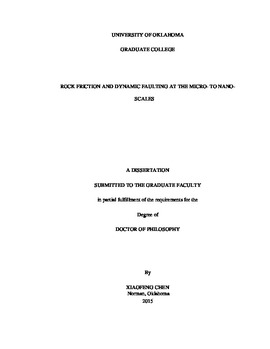| dc.description.abstract | An earthquake occurs when the shear resistance of a crustal fault drops from static friction to dynamic friction during slip. Understanding fault weakening mechanisms is essential for the understanding of earthquake processes. The commonly used rock friction laws are the Byerlee friction law for static-friction (friction between non-moving surfaces, S = 0.6 ~ 0.85, Byerlee, 1978), and the Dieterich rate- and state- friction law for dynamic weakening (Dieterich, 1978). High-velocity slip experiments (velocity from ~1 mm/s to a few m/s), made possible by recent advances in experimental rock shearing instrumentation, revealed new and significant behavior, e.g., strong dynamic weakening at seismic slip rates (Di Toro et al., 2011), or dynamic strengthening (Reches & Lockner, 2010). These new observations challenge the long-standing paradigms. While most previous studies included friction measurements at the macroscopic scale (larger than a few cm2), my research focuses on friction measurements at the micron- to nano- scales. The dissertation presents three mechanisms that are active at these scales, and which can effectively lead to macroscopic dynamic weakening or strengthening.
Chapter 2 summarizes the experimental methods for the rock friction tests and the microscopic characterization techniques. The experimental faults are composed of granite, diorite, dolomite and limestone, and were sheared at high-velocity (up to 1 m/s) under ambient room temperature and humidity, and normal stress of a few to 14 MPa. Analyses of fault surfaces prior to and after shearing utilized Atomic Force Microscopy (AFM) for surface morphology mapping, Scanning Electron Microscopy (SEM) for surface characterization, the AFM colloidal probe method for measuring friction at the sub-micro scale, and X-Ray Diffraction (XRD) and electron microprobe (EPMA) for mineralogical analysis.
Chapter 3 presents a systematic investigation of the relations between surface roughness/smoothness and fault frictional strength. The roughness of the experimental fault surfaces, as represented by their power-spectral-density, correlates well with the measured friction coefficient at the sub-micron scale. The analysis shows that reduced fault roughness by slip leads to the fault weakening, in agreement with the macroscopic observations.
Chapter 4 focuses on powder rolling on granitic faults. The analysis revealed micron-size cylindrical powder rolls that are spontaneously formed and destroyed during granitic faults slip at moderate velocities (0.001-0.1 m/s). The friction reduction due to the powder rolls was calculated using a rolling friction model with good fit to observations. The observed strong correlation between roll occurrence and fault weakening suggests that powder rolling is an effective dynamic weakening mechanism. Further, powder rolling is a likely physical mechanism to explain the enigmatic powder lubrication
The effect of frictional melting of granitic rocks is presented in Chapter 5. I found direct SEM evidence for shear-melting of granite faults that slipped for long distances (tens of m) at moderate slip rates (~ 0.05 m/s). The friction evolution in these experiments was complex: from initial weakening to temporary strengthening, and to the final weakening. The switch from initial weakening to strengthening is related to the phase transition from solid gouge grains to local melting, and its timing is proportional to the dissipative energy. Widespread melt lubrication governs the final weakening similar to bulk melting along gabbro faults.
A summary of preliminary results of high-velocity shear experiments with confined gouge layer appears in Chapter 6. The investigation includes microstructural analysis of experimental fault cross-section produced by focused ion beam milling, fault surfaces, and shear-induced mineralogical alterations in powders of talc, dolomite, clay, and San Andreas gouge. I compared the microstructural results of the solid rock experiments and the gouge layer experiments, and found that slip localization is essentially the in both configurations. I concluded that the development of a central thin principal slip zone structure is critical for the dynamic fault weakening. | en_US |
